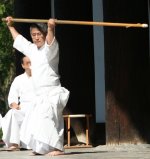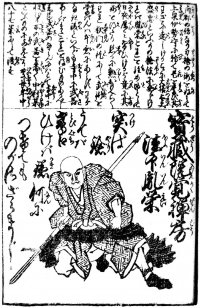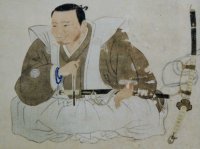 As in most koryū (old schools) the line of head masters from the current sōke Ichiya Junzō back to Hōzōin Kakuzenbō Inei who founded the school is well documented.
As in most koryū (old schools) the line of head masters from the current sōke Ichiya Junzō back to Hōzōin Kakuzenbō Inei who founded the school is well documented.
About the life and doings of the founder of the school on the other hand only relatively litte is known for sure. And the little information that you can find often is contradictory or belongs to the realm of legends.
What is known is that Inei whose secular name was Iga Iga no kami was born 1521 as the second son of a certain Nakamikado Tajima Tanenaga (or Inei) who served as warrior-monk at the Kōfukuji, the most infuential Buddhist temple in Nara. 1533 Inei became monk of a sub-monastary of the Kōfukuji, the Hōzōin. Later he became prior of the Hōzōin.
As a scion of a family the trade of which was war Inei most surely will have been drilled in family techniques; from his childhood on and instructed in naginata and nagamaki, the warrior-monk weapons typical of the time, after his entering the Hōzōin. Much more interesting is that after entering the monastary Inei seems to have developed a real eccentricity about martial arts as he trained in various styles at that time.
Tenshin Shōden Katori Shintōryū and Shinkageryū, just to name two famous schools, were among the styles he practiced. The latter one he studied under Kamiizumi Ise no Kami Nobutsuna together with Yagyū Tajima no Kami Muneyoshi, founder of the Yagyū Shinkageryū (the origin of which is also Nara), who was his good friend after that for the rest of their lifes.
 About the year 1553 according to a contemporary account Inei seems to have had had a kind of enlightenment concerning the use of the sickle-spear. But he was not the inventor of this weapon though the legend that says he was inspired to build a kamayari when he saw the straight blade of his suyari cross the reflection of the crescent of the moon on the surface of the Saruzawa no ike (a pond in front of the Kōfukuji in Nara) sounds very nice.
About the year 1553 according to a contemporary account Inei seems to have had had a kind of enlightenment concerning the use of the sickle-spear. But he was not the inventor of this weapon though the legend that says he was inspired to build a kamayari when he saw the straight blade of his suyari cross the reflection of the crescent of the moon on the surface of the Saruzawa no ike (a pond in front of the Kōfukuji in Nara) sounds very nice.
Whether already Inei had composed a curriculum of forms or whether only his successor Hōzōin Kakuzenbō Inshun who by the way was his nephew systemised the techniques of the school is not clear. Some say Inei himself had written down a total of 15 forms whilst others attribute the arrangement of the school to Inshun . This raises a couple of problems for Inshun only entered the Hōzōin in 1602 when Inei was already an old man of 81 years. So Inshun was not trained in Hōzōinryū sōjutsu by Inei but instructed by a monk who had been Inei's direct disciple. Another problem is that Inei forbade sōjutsu training one year prior to his death (he died on 26.8.1607 according to the lunar calendar). This should have led to the extinction of at least the monastary line of the school. But it didn't because after Ineis death Inshun reallowed the spear training.
Years prior to this prohibition Inei obviously wanted the school that so far had been open only to few to become spread beyond the boundaries of the Hōzōin or Nara. For this reason he personally instructed disciples like Nakamura Ichiemon or Takada Matabê Yoshitsugu who were no members of the monastary community but belonged to the warrior nobility when he was already in his middle seventies. 1605, two years befor Inei died, Nakamura who was 29 years old at that time got his inka (licence). 10 later he granted the first licence himself. Granted it to Takada who was the first among many high ranking disciples Nakamura left which posthumously made him the founder of the Nakamuraha.
 This Takada Matabee became Nakamuras disciple when he was 14 years old and was also instructed bei Inei personally as has already been said. Later he is said to have assisted the second head master (of the monastary line seen from today) Inshun. Besides Hōzōinryū sōjutsu Takada is believed to have been instructed in the use of sword, naginata, bow and so on by masters in their art respectively to finally add the knowledge thus won to the curriculum of the Hōzōinryū as another 101 forms. In addition to this he also is said to be the author of a treatise dealing with strategy, psychology and so om in 50 chapters.
This Takada Matabee became Nakamuras disciple when he was 14 years old and was also instructed bei Inei personally as has already been said. Later he is said to have assisted the second head master (of the monastary line seen from today) Inshun. Besides Hōzōinryū sōjutsu Takada is believed to have been instructed in the use of sword, naginata, bow and so on by masters in their art respectively to finally add the knowledge thus won to the curriculum of the Hōzōinryū as another 101 forms. In addition to this he also is said to be the author of a treatise dealing with strategy, psychology and so om in 50 chapters.
But all this is very uncertain information. Especially if you read elsewhere that Takada got his licence directly from Inei when he was 14 years old and that he was the only disciple that Inei ever instructed in the above mentioned art of strategy and psychology. Well, numbers and facts sometimes get a little mixed up in history especially in Japanese history.
Later Takada founded a sōjutsu dōjō in Edo (nowadays Tōkyō) where he among others instructed a certain Ogasawara Ukon Daifu Tadazane. As a consequence of this perhaps he could enter into the service of the daimyō clan Ogasawara in 1623. At the invitation of Ogasawara Tadazane he moved to Kokura (which belonged to the Ogasawara since 1632) located on the island of Kyūshū in 1637 where he is said to have taken Hara castle which was held by the rebels during the Shimabara uprising leading a platoon of spearsmen.
At the same time as Takada Miyamoto Musashi and his adopted son were also in the service of Ogasawara. So it is not too surprising that these two famous warriors fought a duel on request of their master. The outcome of this sportsmanlike fight again is reported in contradictory versions one declaring Takada the victor while the other one sees Miyamoto victorious.
Takada's disciples and three out of his four sons later spread the teachings of the Hōzōinryū over all of Japan and made the Hōzōinryū the most famous and biggest sōjutsu school of the Edo period (1603 - 1868) with reputedly more than 4.000 disciples.
When and where most of the more than 100 forms did vanish is a mystery. Anyway, a curriculum of only 50 forms yariawase (spear against spear) was all that Yamazato Tadanori taught in the kendō section of the Daiichikōtōgakkō in Tōkyō in 1918.
The return of the Hōzōinryū to Nara began in 1974 when als Kagita Chūzaburō who was the father of the 20th Sōke was elected mayor of Nara (a function his son held as well). Mayor Kagita senior had the central budōdōjō of Nara built which was planned and constructed in a scale suitable for sōjutsu training.\r\nAt the inauguration of the dōjō Ishida Kazuto who was sōke of the Hōzōinryū Takadaha and chairman of the Japanese kendō federation (Zennihon Kendō Renmei) at that time demonstrated Hōzōinryū Takadaha sōjutsu. On request of mayor Kagita he then instructed a handful of men, sometimes in Tōkyō sometimes in Nara, among them the current Sōke and Nishikawa\r\nGennai. The latter was declared his successor by Ishida in 1976 for which reason 1976 is recognized as the year when the school officially returned to its place of birth. The current sōke who trained under Ishida during his university studies in Tōkyō followed Nishikawa in this fuction in 1991.
When the Hōzōinryū returned to Nara a total of 35 forms were left: 14 omote forms, 14 ura forms und 7 shinshikake forms. This is the curriculum that is practiced today in Nara, Higashiōsaka Nagoya and Tōkyō as well as in Hamburg, Germany.
